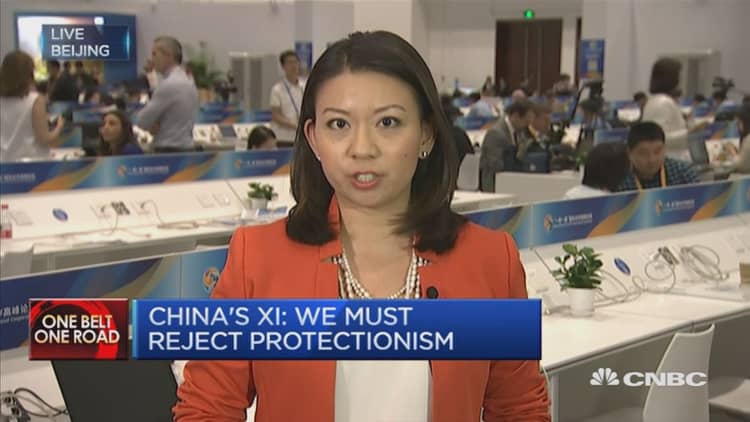China has pitched its mammoth, pan-Eurasian "Belt and Road" infrastructure initiative as a means of promoting economic prosperity and fostering diplomatic ties on a global scale.
That rhetoric may win plaudits at a time when other global powers are voicing increasingly protectionist agendas, but it also comes with risks, and increasing levels of state-backed funding have raised concerns about just how safe of a gamble it is.
Reports on Tuesday claimed that some of China's biggest state-owned commercial banks will begin raising capital to fund investments into the initiative, also known as "One Belt, One Road," which aims to connect more than 60 countries across Asia, Europe and Africa with physical and digital infrastructure.
China Construction Bank, the country's second-largest bank by assets, has been conducting roadshows to raise at least 100 billion yuan ($15 billion) from on- and offshore investors, sources familiar with the matter told Reuters. Bank of China, Industrial and Commercial Bank of China, and Agricultural Bank of China are also said to be raising tens of billions of dollars, though none of the banks responded to Reuters' request for comment.
The news highlights the risk that the state could amass hundreds of billions of dollars in nonperforming loans if the projects fail. For Xu Chenggang, professor of economics at Cheung Kong Graduate School of Business in Beijing, it was not a surprise.
A risk to China's banking system is, by default, a risk to the global banking systemBjorn Conradvice president at the Mercator Institute for China Studies
"It supports my concerns," Xu told CNBC over the phone. "The impact could be damaging not just for China, but for the global financial system."
"These loans are being extended to governments in risky countries to fund risky infrastructure projects. If the projects were launched by private firms we wouldn't have to worry because they would know they had to bear the consequences. But here we are talking about government-to-government lending and, ultimately, intergovernmental relations."
Xu attributed that issue to a phenomenon known as soft budget constraints.
Soft budget constraints refer to the idea that state-owned firms will not be allowed to go bankrupt if they go insolvent because the state has vested interests in keeping them afloat. A country with high soft budget constraints and a large number of insolvent firms may then struggle for financing, which could have global financial implications.
For a country like China, where state-ownership has historically been high, this is a matter of particular concern. It took decades of economic reforms and loss-making firms before it succeeded in what Xu termed a process of "quiet privatization" at the turn of the 21st century.
However, the process has lost momentum over the past 10 years, and the state remains burdened with issues of overcapacity and myriad "zombie firms," especially within the metals and construction and materials sectors.
Xu said that has partially been the motivation for the "Belt and Road" initiative: "Instead of solving the overcapacity problems, they are expanding the problem to projects overseas."
"They (China) are proposing lending money to foreign governments, who will then use the Chinese funds to pay the Chinese companies," he explained.
China's debt to gross domestic product (GDP) ratio surpassed 300 percent in June, according to the Institute for International Finance. And that's before the extension of further loans.
"Expansion of these soft budget constraints at such an unprecedented rate and in such a large scale is going to generate unprecedented consequences," Xu noted.
Crucially, the countries tied to the "Belt and Road" initiative are some of the riskiest developing countries in the world. A number of research bodies are now risk assessing the political, economic and business landscapes of the involved nations.
"There is no doubt in my mind that there will be a large number of projects that will have unforeseen problems," Bjorn Conrad, vice president at the Mercator Institute for China Studies, told CNBC. "There are considerable risks of nonperforming credit in many of these projects and high risks of default."
"A risk to China's banking system is, by default, a risk to the global banking system," he continued.
However, he noted that the government would be working hard to assess risks after it was badly burned by lending to volatile countries such as Venezuela.
China's National Development and Reform Commission announced last week that it would strengthen regulation to reduce risk for domestic firms investing overseas and prevent "irrational" investment in the "Belt and Road" initiative.
"There will be an enormous amount of loans to give out, on a different scale to ever before, but also an awareness that they (the Chinese government) have to keep these at a manageable scale," Conrad said. "There will still be risks, but an understanding that they have to be managed with more scrutiny."



